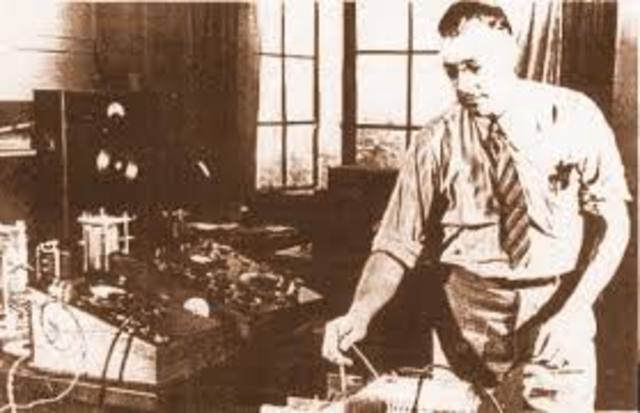
Donald Lewes Hings (1907-11-06 – 2004–02-24) was born in Leicester, England, but moved to western Canada with his parents when he was three. He grew up in Rossland, in the Kootenays, halfway between Vancouver and Calgary, and 10 km north of the Canada/ United States border.
He was a pioneer in the field of telecommunications, and best known for his invention of the Walkie-Talkie. Previously, mobile radios were mounted on vehicles and transmitted in Morse code. Hings’ model, developed in 1937 while working at Consolidated Mining and Smelting Company (CM&S) now, Cominco) in Trail, British Columbia, was portable and could transmit the human voice over long distances. He called his invention the packset.
During the Second World War (1940-1945) Hings worked for the National Research Council, on loan from CM&S, working with the Signal Corps to develop military communications, including the military walkie-talkie. From 1946-1985, he worked for Electronic Laboratories of Canada as President & Chief Engineer. The company was started 1942-11-02 as a subsidiary of Electronic Laboratories, Inc. of Indianapolis, Indiana, USA. It was dissolved 1998-09-21.
Between 1975 and 1993, he devoted his time to developing instrumentation for measurements of the causes and effects of long-range air pollution vectors.
In 1946 he was awarded the Member of the British Empire by King George VI. In 2001 he was presented with the Order of Canada by Governor General Adrienne Clarkson. In 2006 he was inducted into the Telecommunications Hall of Fame because “his modifications of the two-way radio … which he evolved into the world’s first functional and operational walkie-talkie, saved the lives of thousands of British, Canadian and American troops during the Second World War and helped to usher modern telecommunications technologies into the military”.
Despite being a lifetime member of the Professional Engineers Associations of British Columbia and Ontario, the American Geophysical Union and the Canadian Signal Corps, his professional education was self-taught. He had no university education.
His life work includes a wide-range of antenna, radio technologies and geophysical exploration techniques using electromagnetic instrumentation that he developed. He has more than 55 patents to his name in both Canada and the US.
On 2000-02-13 Roger Chaisson, Bruce Waugh and David Billings were awarded the People’s Choice Award at the Ottawa Winterlude Festival for their 4 m tall ice sculpture dedicated to Don Hings. It depicted a Red Cross soldier in the Second World War, speaking into a C-48 walkie-talkie.
Hings was adept at Morse code, and was an amateur radio operator, with call sign VE7BH. His obituary notes that he talked to “HAM boys” well into his 90s.
Hings lived in Burnaby, a municipality immediately east of Vancouver, at the summit of the 203 m high Capitol Hill, a neighbourhood north of Hastings Street, east of Willingdon Avenue, and west of Fell Avenue, known for its Italian, Portuguese and Croatian immigrant communities. He first saw Capitol Hill on a Scout outing in 1918, and decided then and there that he wanted to live there. He bought ca. 2.5 city blocks of the area, built his house there in the late 1940s. This is where he lived and worked for the rest of his life.
He located his business on a compound at this site. Seven of the staff members that worked for him in Ottawa, relocated to Capitol Hill when the company was established. Ultimately, he sold building lots to a staff of 15 at the same price he had paid for them, so they could live close by their place of work.
In addition to other patents, he has one for an electric piano. It consists of tuned steel bars that set up a moving magnetic field that creates pure tones, minus the harmonics, It is small, compact and never needs to be tuned. In addition it is equipped with a speaker and volume control.
Much of the information for the Weblog post is sourced from the D. L. Hings website.



Truly impressive accomplishments for a man who had no formal professional training and who lacked an accredited University degree.
His pioneering work with walkie talkies in 1937, while working for Cominco in Trail BC, predates my first full time employment position in Canada with the same company during the early ’80’s recension. When I began there, layoffs were already underway. I wondered how long it would take for the latest newbies to be noticed. Two years later, there was a summons to the engineering department manager’s office where a dreaded pink slip was reluctantly handed to me. He’d been instructed to lay-of 20% of his staff.
Cominco, one of the worlds largest zinc and lead producers, is now, known as Teck Resources Limited, a large company with global mining operations.
I was fortunate to move through different careers during my working years, ending as a water resources engineer with a conservation authority – working as a protector of watershed environments, instead of for a heavy polluter, was much more satisfying.